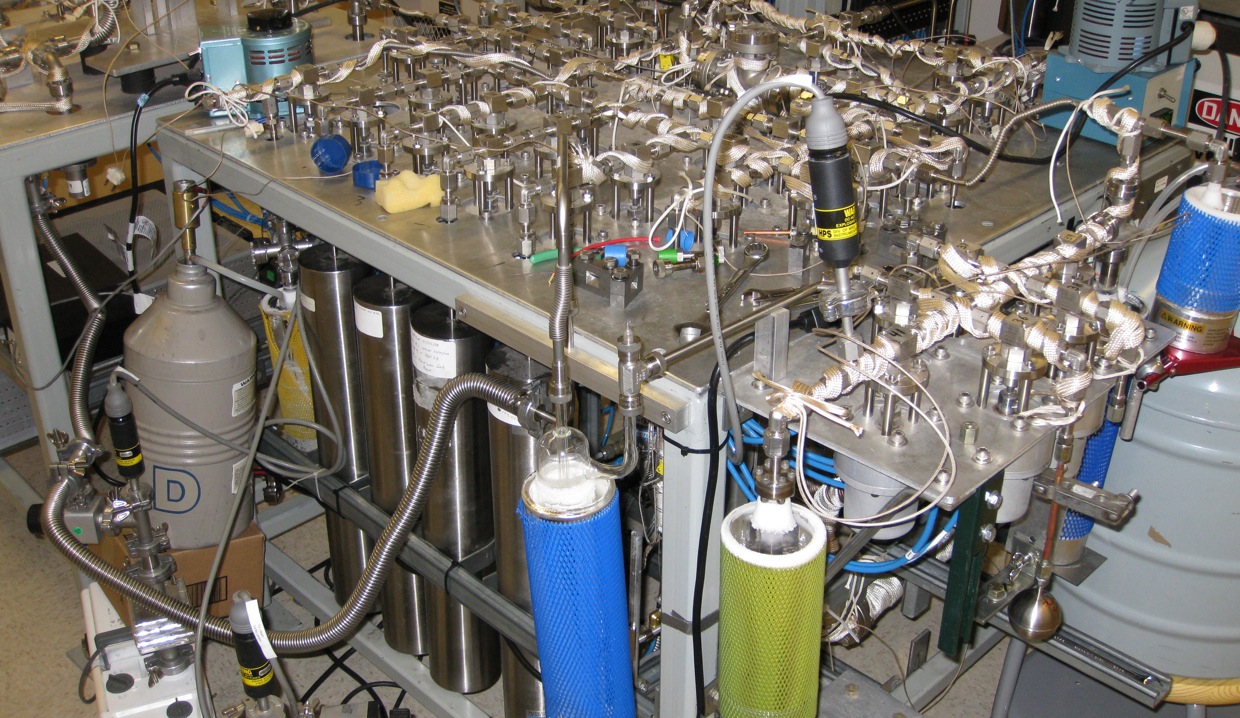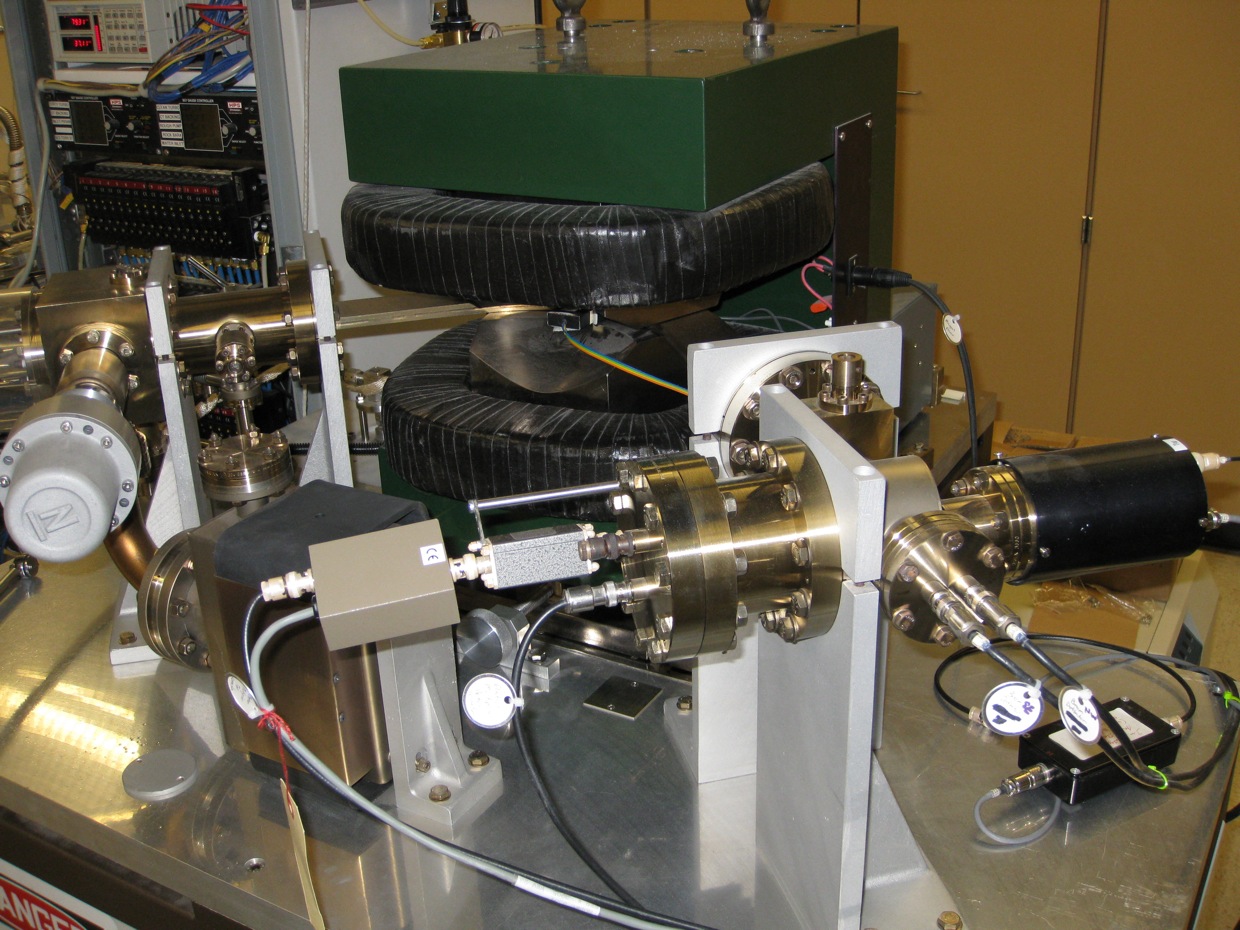Dissolved and Noble Gases
 The majority of the lab’s research involves isotopic measurements of noble gases for
groundwater age dating and thermometry. Our lab works with and accepts two types of
samples for dissolved gas measurement: Copper Tube Samples and Diffusion Samples.
Copper tubes are collected by pumping through an inline copper tube, and sealing the
tube off using refrigeration type clamps. The dissolved gases in these samples is
then extracted using our extraction line. Under high-vaccuum, closed system, the water
is transfered from the copper tube into a large stainless steel flask. The flask is
heated while a a smaller flask is chilled. This creates flux of gas from the large
flask, into the small flask. The small flask is then sealed before being transfered
to the mass spectrometry line.
The majority of the lab’s research involves isotopic measurements of noble gases for
groundwater age dating and thermometry. Our lab works with and accepts two types of
samples for dissolved gas measurement: Copper Tube Samples and Diffusion Samples.
Copper tubes are collected by pumping through an inline copper tube, and sealing the
tube off using refrigeration type clamps. The dissolved gases in these samples is
then extracted using our extraction line. Under high-vaccuum, closed system, the water
is transfered from the copper tube into a large stainless steel flask. The flask is
heated while a a smaller flask is chilled. This creates flux of gas from the large
flask, into the small flask. The small flask is then sealed before being transfered
to the mass spectrometry line.
Diffusion samples are collected in one of two forms. The standard method involves a short piece of silicone tubing with short copper tubes on either end. The copper tubes are cold welded on the outer ends. With the sampler submerged in a well, gas exchange through the silicone tubing occurs and with time, the gas inside the sampler should be a equilibrated with the groundwater's dissolved gas content. The sampler is retrieved and copper tips are cold welded, sealing the gas sample inside. This technique is simple and efficient, however, samplers need to be quickly removed and sealed before gas exchange occurs at the surface.
To address this time issue, the Dissolved & Noble Gas lab has created an Advanced Diffusion Sampler. The sampler is capable of actuating at depth via 1/4" polyethylene tubing. Actuating the sampler temporarily seals the sampler tip, allowing minutes to hours before sealing the sample with a refrigeration type clamp.
Both Diffusion samplers can immediately be analyzed with the mass spectrometer without any additional processing, giving quicker turn-around times than copper tubes.
Our analysis line consists of two mass spectrometers (MS): a quadrupole MS and a magnetic sector field MS. The quadrupole mass spec uses four, parallel, charged rods that isolate specific ions with given mass/charge ratios. Different electrical charges radio frequencies allow different ions to pass through the quadrupole to a detector. The quadrupole MS is used to quickly determine the abundance and isotopic analysis of most atmosphere gases. Our system uses a Stanford Research SRS – Model RGA 300 quadrupole mass spectrometer. Measurements for all gases except helium are made using this instrument. These includes: 28N2, 36Ar, 40Ar, 20Ne, 22Ne, 78Kr, 84Kr, 86Kr, 126Xe, 129Xe, 131Xe, 132Xe, 134Xe, 136Xe.
Like the quadrupole, the sector-field mass spectrometer uses ions' mass/charge ratios, but in this case, a magnet is used to deflect the ions into separate detectors. Our lab uses a Mass Analyzers Products – Model 215-50 Magnetic Sector Mass Spectrometer. This is used to precisely measure abundances of 3He and 4He. An electron multiplier is used to measures low-abundance ions with high-precision, while a Faraday cup measures more abundant ions.

Magnetic Sector-Field Mass Spectrometer
The mass spectrometry system line design is based upon the design described in “A Static Mass Spectrometer With Triple Collection For Nitrogen and Neon Isotopes”, Scripps Oceanographic Institute, S.I.O Reference Series # 93-11, September 1993. Atmospheric gas components are measured and removed using SAES getter technology (see SAES) and cryogenics. The system is held at high vacuum using a combination of rough pumps, turbo pumps, getters and ion pumps. The entire system is computer controlled through two computer systems utilizing National Instruments hardware and software.
Gas Standards - A tank of “dry” atmosphere is prepared as a daily standard. All Analytical calibrations are made using this standard. In additional, air equilibrated water samples, collected at different temperatures are analyzed as blind standards. Typically, four standards are analyzed for six unknown samples in a given day. The daily schedule is: two standards are run in the morning to ensure proper communication and re-center the peaks, 3 unknown samplers are run followed by a standard. If the standard is acceptable, three more samples are analyzed which are followed by a closing standard. In addition, one air equilibrated water sample is analyzed for approximately every ten unknown samples.
Data analysis – During an analysis, all pertinent information is collected by computer and imported to an Excel worksheet. Three files are produced for every one analysis. On a daily basis, these files are “compiled” into a single workbook using Visual Basic code developed in our lab. This code incorporates the daily standard runs and produces a final sample report. These reports are then reviewed by hand and used in the age calculation process.
